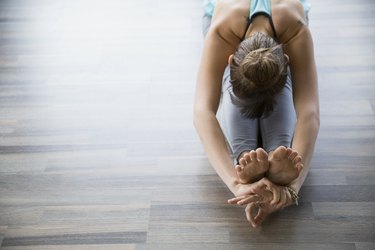
Gluteus maximus, the largest muscle in the body, helps power you up hills and stairs and supports your hip and pelvis while squatting and lunging. Treatment for a gluteus maximus injury depends on the type and severity of the injury.
There are several things to do at home to ease the discomfort and promote healing, especially for mild injuries. Controlling inflammation and an appropriate exercise routine are key steps to a complete recovery and return to daily activities and athletics.
Video of the Day
Video of the Day
Grading a Gluteus Maximus Injury
A strain or tear of the gluteus maximus can occur during athletic activities, most likely while playing dynamic sports that require running, jumping and quick accelerations. The gluteal strain can be graded as minimal, moderate or severe. These grades correspond roughly to the approximate severity of symptoms and time frame for healing.
A minimal strain will heal faster than a moderate or severe strain and it can typically be managed with a home treatment program. If you have moderate to severe pain, or if you're having difficulty moving your hip, you may have a more serious injury and should consult your doctor. Severe gluteus maximus muscle tears may require surgery.
Home Remedies for a Pulled Glute
Immediately after a muscle injury, the American Academy of Orthopedic Surgeons recommends applying the principles of RICE — rest, ice, compression and elevation. This will help with pain and inflammation. You may also consider over-the-counter medications, such as ibuprofen (Advil, Motrin), after consulting your doctor.
You will want to be cautious during this initial phase of healing, which lasts one to three days. Once the pain and inflammation have subsided, you can start gentle hip range-of-motion exercises and progress to more challenging exercises as tolerated.
Exercise and Rehabilitation
Rehabilitation for a pulled glute includes stretching, aerobic activities and strengthening. Gentle stretching is necessary to prevent stiffness of the muscle and surrounding tissue. Aerobic exercise helps by increasing blood flow and oxygen delivery to the injured muscle and promotes healing. Performing aerobic activities also warms up the muscle and allows for easier stretching.
Strengthening exercises should be incorporated to fully restore muscle function. According to Physiopedia, lower-level gluteus maximus exercises are performing lying down. As strength increases, exercises are progressed to the highest level of difficulty. These exercises can include lunges, step-ups and squats. When doing exercises, start gradually and increase the intensity until you are able to do these two activities normally.
Read more: Exercises to Reduce Pain in Gluteus Maximus
When to See Your Doctor
If your injury appears to be moderate to severe, seek advice from your doctor before beginning any treatment at home. Any time your pain worsens while exercising, stop the activity and consult with your doctor. Also, contact your doctor if the pain does not seem to be improving or is getting worse over time. This may indicate that your pain is not actually caused by a pulled glute.
The gluteal region is a common area of referred pain, meaning the pain you feel may be coming from a different location, such as your lower back. Your doctor can help determine the cause of your pain and advise you on the most appropriate course of treatment.
Is this an emergency? If you are experiencing serious medical symptoms, please see the National Library of Medicine’s list of signs you need emergency medical attention or call 911.